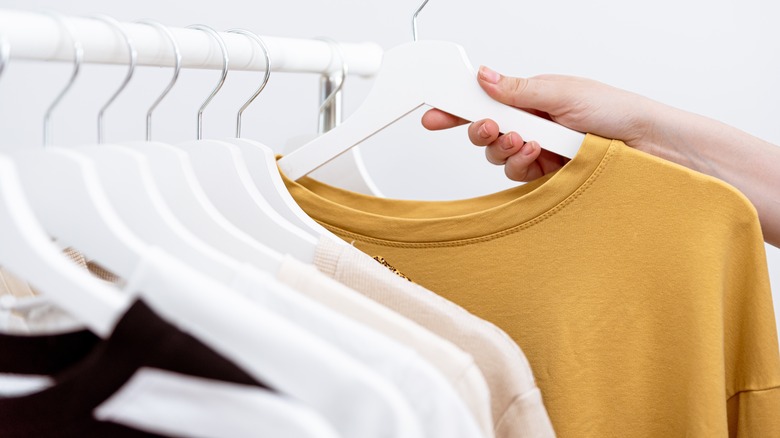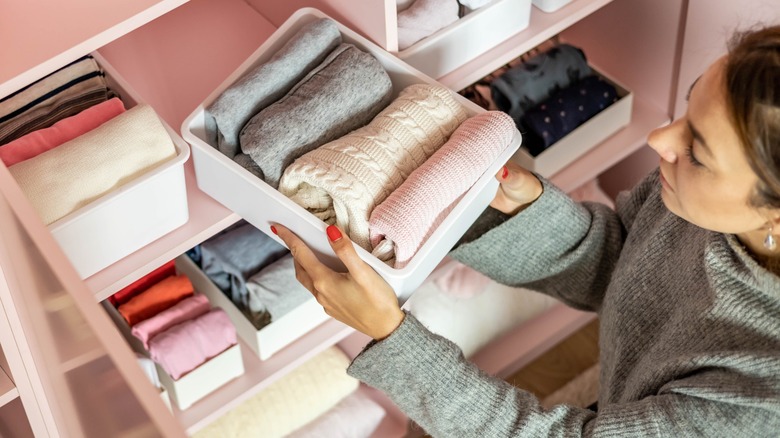Cost Per Wear: The Fashion Tool To Help Your Sustainability Journey
Conspicuous consumption might be good for the economy but not for the environment. In the U.S. alone, each person generates 100 pounds of textile waste on average every year, per the Boston University School of Public Health. The easiest way to reduce textile waste and pollution is to purchase fewer, better-quality garments that won't end up in landfills within three to five years. Plus, it saves you lots of money. If you take a long, hard look at your wardrobe, you'll find many pieces of Sunday's best sitting unworn and collecting dust. When new trends come, and your attitudes change, you will want to replace them, no matter how fancy.
If sustainability and better financial management are not convincing enough for you to start adopting a more mindful approach to shopping, maybe cost per wear can help. Nothing puts people — even shopaholics — in a defensive mode faster than money talk. Cost per wear is a formula that enables you to break down the initial upfront cost of a garment by how many times you will wear it. This equation helps you see the value of an item in direct correlation with the number of times you will be using it. Doing the cost-per-wear calculation before buying anything enables you to make more thoughtful purchases and avoid overspending. Here's how.
How to calculate cost per wear
Cost-per-wear is calculated by dividing the cost of that item by the projected number of times worn. For instance, it's wintertime in your area, and you're standing before a $600 coat, wondering whether it's worth your money. If the winter lasts at least 120 days and you'll need to wear that coat at least once per day for every day of that year, your estimated number of wears in the first year is 120. Now, divide $600 by 120, and your cost per wear is $5.
However, if you're living in a country with a hot climate all year round and you're buying this designer coat just so you can wear it during your once-pear-year 7-day vacation trip to a city with cooler weather, your estimated number of wears in the first year of the purchase is 7. If you do the math, your cost per wear now is $17.
Between these two scenarios, the latter is a less sensible purchase because it sits unworn for a longer time. Unless you're a fashion archiver, stocking up on clothes and not wearing them does no good. The lower the cost per wear, the better the deal. The higher the cost per wear, the less valuable that item is for you in the long run.
In what context should cost per wear be applied?
First and foremost, you should only apply a cost per wear to things that can be used multiple times. You don't apply cost per wear to a wedding dress, state dinner-ready ball gown, or Halloween costume.
To make your cost-per-wear calculation more practical, there are certain factors you should consider when doing the math. For instance, consider the fashionability of the garment or the handbag. Some items have timeless appeal, such as a suit, a little black dress, a denim jacket, and a traditional trench coat. These are some pieces that will never go out of style and can be donned season after season.
Another thing to consider is versatility and practicality. Can this piece be mixed and matched with other clothing items? For instance, if you're eyeing a skinny scarf, how do you see yourself layering it with other pieces in your closet?
Lifespan is also an essential factor. You shouldn't spend much money on items with a limited lifespan, such as underwear. You don't need cost per wear for undergarments. You wear them daily, expose them to all sorts of wear and tear, and typically replace them yearly.
Benefits of cost per wear
Using cost per wear in your shopping habits has lots of benefits. First of all, this methodology is good for your overall financial health. It invites you to weigh the pros and cons before buying something and encourages you to invest in pieces that could last you a lifetime, which helps curtail your tendencies to overspend. Your wardrobe also looks less cluttered with fewer clothes, and you won't have to spend too much time and effort sorting out garments, doing laundry, and sifting through the racks to find your #OOTD.
Keeping your wardrobe minimalist might also help with the rodent problem. When you have too many clothes to fit into your wardrobe, you tend to lay them around, and rats love that. Since they frequently reside in unclean and chaotic environments, they will have a place to hide in your enormous pile of filthy laundry and chew on the pieces. Above all, you're helping the planet. Fewer clothes mean less production, reduced textile waste, and decreased carbon emissions per garment.
Does cost per wear encourage a style rut?
Ditching fast fashion doesn't mean you'll always find yourself in a style rut. A capsule wardrobe — a limited selection of outfits that can be put together in many ways and worn on numerous occasions — is a great way to create different looks with a limited number of clothing pieces. A capsule wardrobe can include as many or as few garments as you choose as long as they suit you and make your daily dressing easier. But if you're determined to go the minimalist route, have no more than 50 pieces.
Classic, basic pieces such as a blouse, a jumpsuit, an A-line skirt, staple jeans, a sheath dress, a silk scarf, and a blazer can easily be styled up or down. Stick to a single color palette to keep your coordination game strong. Neutral hues like white, black, grey, beige, cream, and khaki are good ideas. For instance, a little black dress paired with a white blazer and a pair of cream pumps is a look that can be worn in any season and on any occasion. If you want a splash of color, build your wardrobe according to the rainbow color palette — red, orange, yellow, green, blue, indigo, and violet. Building a selection of well-curated, readily replaceable pieces helps keep your closet basic while still looking stylish.
How to care for your slow-fashion closet
To maintain your high-quality slow fashion closet, set up a great store with care and repair. When it comes to washing clothes, always read the labels for instructions. Some clothes require dry cleaning only, while some need to be hand washed. If there are stains on your garments, treat them immediately to prevent them from setting in. If you're not confident with your spot-treating and cleaning skills or don't have the right tools for the job, always seek a professional cleaner for help.
To prevent heat damage and wrinkles in the fabric, instead of using a dryer, let your expensive garments air dry by laying them flat and turning them over every 30 minutes. Care-wise, apply creams, deodorants, and perfume sprays before putting on your high-end garments to avoid staining your clothing. To keep your knitted sweaters and stretchy activewear in good shape, fold them, don't hang them. Jackets, dresses, blouses, pants, and linen items should be hung. In addition to that, invest in quality, sturdy hangers and garment bags to help keep your clothes in good condition.





